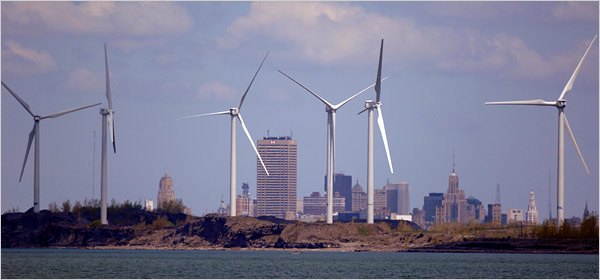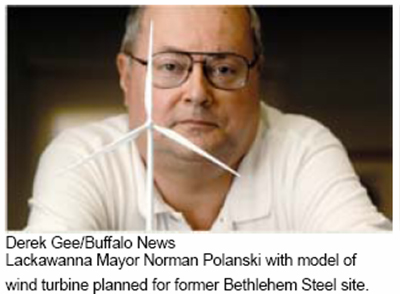Lackawanna, New York
SteelWinds, former Bethlehem Steel site, Lake Erie
(8) 2.5 MW turbines (equivalent to 6,000 homes) with plans for 27 total
Development Timeline: 2001 - 2007
Owners: BQ Energy (Patterson, NY) and UPC Wind (Newton, MA)

Photo credit: Doug Benz/New York Times
“We were the old Rust Belt, with all the negatives. Right now, we are progressive and we are leading the way on the waterfront.” – Mayor Norman L. Polanski, Jr. (1)
Site:
The Steel Winds project is located in Lackawanna, New York, just south of downtown Buffalo. The wind farm is a part of the redevelopment of a 1,600-acre brownfield site once home to Bethlehem Steel. Once one of the world’s largest steel mills (2), the mill stopped operation in 1983.(1) The ground is composed of steel slag and is polluted with other contaminants. The wind farm’s first phase occupies 32 acres of the property along Lake Erie.(3)
The property is owned by Mittal Steel, which leases the land to the wind farm developers. Mittal Steel acquired the property when it acquired International Steel Group in 2005. Mittal Steel’s hope is that inexpensive on-site electricity and a cleaned up site will attract new industry to locate at the site.(4) This is the hope of local city and county governments as well, who see the wind farm as the catalyst of a larger industrial redevelopment effort. (1)
Yet the largest benefit being touted by public officials is the project’s effect on the area’s image. BQ Energy, noting nearby Niagara Falls, describes this part of Western New York as the “world-wide capital for renewable energy.”(3) According to the New York Times: “The road from Buffalo to this city to the south offers a stark reminder of the region’s faded past as a hub of industry and shipping. Yet in the past few months, a different sight has emerged on the 2.2-mile shoreline above a labyrinth of pipes, blackened buildings and crumbling coke ovens that was once home to a behemoth Bethlehem Steel plant: eight gleaming white windmills with 153-foot blades slowly turning in the wind off Lake Erie, on a former Superfund site where iron and steel slag and other industrial waste were dumped during 80 years of production.”(1)
Project History:
Construction on the site started in September 2006, the wind turbines were delivered in early 2007, and the facility began operation in April 2007. However, planning for the project lasted for several years. In the Fall of 2001, graduate students in the Department of Planning at the University at Buffalo created a report in partnership with the Buffalo Urban Renewal Agency titled “Wind Energy Initiatives for Greater Buffalo.”(5) The report investigated the potential of wind power in the Buffalo, Lackawanna, and Hamburg lakefront areas, finding great potential at the Bethlehem Steel site. The report recommended the formation of an inter agency public-private Action Group to study the implementation of its findings, and states that “The impetus behind this study has been the recent interest of private wind farm developers who have approached Erie County, the City of Buffalo, Bethlehem Steel, and the Green Gold Corporation.”
Following the completion of the study, a Wind Action Group was in fact formed by Buffalo’s Green Gold Development Corporation (6). The Wind Action Group, driven by a desire to bring clean manufacturing and jobs to Buffalo, focused effort on bringing a wind demonstration project to the area, noting on its website that “currently, there are no operating urban wind farms in the U.S.”
In 2002, The Erie County Department of Environment and Planning undertook a “Shoreline Wind Study” with funding from the New York State Energy Research and Development Authority (NYSERDA). The study undertook wind monitoring at several sites along Lake Erie and concluded that overall the shoreline had excellent wind energy potential, though 1) Annual mean wind speeds vary inversely as distance inland from the lakeshore increases and 2) “Surface roughness effects (i.e., the developed nature of the sites and adjacent parcels) appeared to play a major role in determining the wind resource at each monitoring site; average wind speeds were observed to drop quickly less than 2 kilometers inland.”(7)

Ownership:
BQ Energy (Patterson, NY)
BQ Energy “paved the way for the project by finding the site, arranging the brownfield grants, negotiating the lease and accelerating the permitting” and “turned to UPC as co-developer to harness its wind farm construction expertise.” (8) Mark Mitskovski, BQ Energy’s Project Manager, was formerly Erie County Director of Energy Development and Management, where he established the County’s wind development intiative and laid the groundwork for SteelWinds.(9) BQ Energy focuses on developing clean energy projects at heavy industrial brownfield sites, particularly oil refineries and steel mills.(9) They reportedly have several projects in development, and benefit from the tax credits and indemnification of the New York State’s brownfields program. BQ Energy is also trying to locate a wind farm at Fresh Kills landfill on Staten Island, and was part of a failed attempt to locate wind turbines at the top of Manhattan’s Freedom Tower.(3)
UPC Wind (Newton, MA)
UPC Wind is a developer, owner, and operator of wind farms with more than 40 wind farms in development across the country.(10)
"The economic effect of the wind farm on this city will never rival that of the steel giant. [Project manager Mark] Mitskovski estimated that Steel Winds will ultimately employ a few dozen people,compared with the tens of thousands who punched the clock at Bethlehem. And though there are incentives for clean energy production, taxes generated by the wind farm will never match those paid by the steel mill, which at one time subsidized most of Lackawanna’s government. The greatest effect of the eight windmills, however, may have more to do with attitude. 'A community that has had difficulty moving forward has accepted a technology that leapfrogs other forms of energy generation,' Mr. Mitskovski said. 'Decades of steel-making created this environmental legacy. But that also created the opportunity to take this fallow, contaminated land and reuse it.'" (1)
Current Situation:
The project's continues, with planned expansions on the site in the jurisdictions of both Lackawanna as well as the neighboring town of Hamburg. In June of 2007, the Hamburg Town Board passed a commercial wind ordinance that cleared the way for six additional turbines. The generous ordinance was praised by SteelWinds' project manager Mark Mitskovski as "probably the best wind ordinance in the state." (13)
Lackawanna Council and Planning Board officials have been discussing the expansions in Lackawanna since June. One point of discussion is whether the developers, who are tax exempt but will pay the city $100,000 annually, should pay additional fees for an expanded project. (14) The developers' plans call for an additional 5 turbines along the lakeshore for a total of 13, plus a second row of 13 turbines inland. (15)
Meanwhile, as Erie County, wind developers, and Mittal Steel continue to assess further sites on Lake Erie for wind farm development, the SteelWinds project might offer a model for simultaneously helping redevelop abandoned industrial sites and reducing public opposition. According to the Buffalo News, “The developers of Steel Winds…are hoping that by putting their wind farm on a polluted ‘brownfield,’ the public will be more amenable. That's exactly the niche market BQ Energy is going after.”(3)

Photo credits: Doug Benz/New York Times (left), David Duprey/AP (right)
Sources:
1) Staba, David. “Old Steel Mill Retools to Produce Clean Energy.” New York Times. May 22, 2007. <www.nytimes.com/2007/05/22/nyregion/22wind.html>
2) <www.clipperwind.com/feature_steelwinds.html>
3) Becker, Maki. “Towers of Power along the Lake.” The Buffalo News. August 20, 2006.
4) Krouse, Peter. “Turbines are Breath of Fresh Air in Mill: Mittal Steel explores viability of similar project near plant in Cleveland.” The Plain Dealer. June 10, 2007. Downloaded 12/9/2007 <www.cleveland.com/green/index.ssf?/green/more/green0610.html>
5) “Wind Energy Initiatives for Greater Buffalo.” Master of Urban Planning Fall 2001 Workshop. University at Buffalo. <www.greengold.org/wind/articles.php>
6) Wind Action Group <www.greengold.org/wind>
7) Erie County Shoreline Wind Study: Final Report. Prepared for NYSERDA by Erie County Department of Environment and Planning and Ecology & Environment, Inc. November 2005. <www.erie.gov/environment/pdfs/Shoreline_Wind_Study.pdf>
8) Robb, Drew (Clipper Windpower) “Wind farm helps bring new life to a derelict urban steel mill.” Engineer Live. Downloaded November 8, 2007. <www.engineerlive.com>
9) <www.bqenergy.com>
10) <www.upcwind.com>
11) <www.steelwinds.com/steelwinds>
12) <www.ci.lackawanna.ny.us/lackawanna.htm>
13) Gusmorino, Sabrina. "Wind-Energy Ordinance Wins Approval in Hamburg." New York League of Conservation Voeters. June 26, 2007. <www.nylcv.org>
14) McNeil, Harold. "Lackawanna Pursues Wind Farm Review Powers." The Buffalo News. June 29, 2007. Dowloaded from <www.windaction.org/articles/10460>
15) Anderson, Dale. "Planners Delay Action on Expanding Wind Farm." The Buffalo News. September 13, 2007. Page B3.
|
